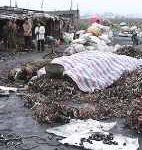After every lecture, Chang Yongguan was the first person to ask a question. And he used the short breaks between lectures to talk with the speakers. But Chang is not a university student trying to improve his academic record. He is the deputy head of Dadukou district in Chongqing, one of the most populous cities in southwest China, under the direct jurisdiction of the central government.
The lectures were part of a week-long training session at the National Mayoral Training Centre, organised by Joint US-China Cooperation for Clean Energy (JUCCCE), which gathered 25 mayors in Beijing to discuss how to establish “resource conserving and environmental protecting” cities.
Chang became deputy district head last year after spending around 20 years at Chongqing Environmental Protection Bureau. Along with his record of administrative performance, Chang’s strong background in environmental protection helped with his promotion.
He hoped the training session, which featured lectures from leading experts in China and other countries, would help illuminate his search for solutions to the increasing pressures of an urbanising population and deteriorating natural resources.
One of 12 districts in Chongqing, Dadukou has a population of more than 240,000. This will grow to 450,000 by 2020. According to the eleventh Five-Year Plan, the city will maintain an annual economic growth of 12% from 2006 to 2010. The district is the city’s industrial base, with large-scale iron and steel plants. It has long been affected by emissions of sulphur dioxide and other pollutants, resulting in acid rain and health problems for residents, including asthma.
Chang has to seek a balance between maintaining economic growth and ensuring a clean environment for a growing population. His colleagues at the training course face similar problems, whether they are from rich cities, such as Beijing and Shanghai, or from poorer areas, such as the provinces of Gansu and Guizhou.
The speedy pace of China’s urbanisation will see some 400 million people move to the cities over the next 15 to 20 years, the equivalent of two New York Cities every year. This is likely to mean constructing 50,000 skyscrapers, 170 new public transport systems and 12 megapolises of 60 million people or more.
Rob Watson, founding chairman of the Leadership in Energy and Environmental Design (LEED) green building rating system, says China’s fast urbanisation is a challenge similar to a war, with mayors the “warriors at the frontline of the battlefield.”
This is no exaggeration, as China attempts to support 21% of the world’s population with 7% of its arable land and water, 4% of its oil and 2% of its natural gas.
Qiu Baoxing, China’s vice-minister of housing and urban-rural development, gave the first lecture, which focused on solutions, but also the difficulties that face the orderly urbanisation of China.
“Some mayors have historically made mistakes about common sense in urban planning. For example, reclaiming land from rivers and lakes,” Qiu said. “It really destroys the local ecosystem. It also shows the importance of a mayor updating his or her knowledge about urban planning.”
Zhang Chunxiang, deputy mayor of Xinyang, in Henan province, said: “The lectures, especially those given by the foreign speakers, are very inspiring and helping us broaden our horizons, although importing the ideas into China demands some localisation.”
After listening to lectures by Nicky Gavron, the former deputy mayor of London, and Stephen Hammer, professor at Columbia University, Zhang was inspired but also confused.
“It would be good to integrate energy planning into urban planning, for instance,” said Zhang. “But the lectures made it clear that any high-profile urban plan will require 10 to 20 years to complete. Since Chinese local government officials are subject to reshuffles every four years, there is question of how to ensure the continuity of an urban plan through several cycles of government.”
Some mayors had long-standing misconceptions about energy-saving and environmental protection corrected during the course. For instance, although Chang was an environmental expert, he still discovered he was mistaken to have believed that a central air conditioning system was an energy-saving solution for office buildings.
“It looks like we need to retrofit our office buildings with separate air conditioners, because it is a flexible way to meet varied demand,” he said. “On the weekends or holidays, for instance, no energy will be consumed.”
China’s current Five-Year Plan aims to build a resource-conserving and environmentally friendly society, with targets to cut energy consumption per unit of GDP by 20% and reduce emissions of major pollutants by 10% from 2006 to 2010.
But mayors do not have detailed guidelines from the central government on how to implement the plan, since the situation varies from city to city. Each mayor must determine a path tailored to the city’s unique situation. This is why the mayors showed such enthusiasm for the course, which also provided an opportunity to talk with leading environmental experts and professionals, and help the transition to a low-carbon future.
Sun Xiaohua is a senior journalist at China Daily.
Homepage photo by kindsir

